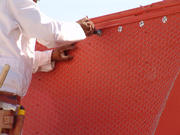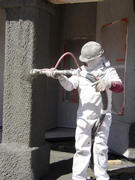KRATOS Wall System
History of Stucco
Historically, “plaster” was the term used to describe exterior coating, particularly lime based coatings, on building structures. In some areas “plaster” is still used in that connotation. ‘Stucco’ was the term used to denote interior ornamental plaster works in building structures. In the United States, during the 19th century the term “stucco” began to be used to describe exterior plastering.
Stucco has been used for a very long time. Prior to the development of Portland cement in the late nineteenth century, stucco was a lime-based mixture of mud, clay, chalk, cement, gravel, straw, or animal hair. Other names for stucco like exterior treatments are: rendering, parging and pargeting, wattle and daub, cob or chalk mud, pise de terre, rammed earth, briquette entre poteaux or bousillage, half-timbering, and adobe.
Early in the development of our country stucco was recognized as an important building material as our ancestors desired to emulate the European architectural fashions like Greek and Gothic Revival. As the quality of stucco improved it facilitated the development of additional architectural styles such as Prairie, Art Deco, Art Modern, Spanish Colonial, Mission, Pueblo, Mediterranean, English Cotswold Cottage and Tudor Revival, bungalow and Spanish Colonial Revival.
Stucco has been popular because it is inexpensive, can be used over less finished and less costly substrates and it is easily dressed to simulate expensive furnishings. Portland cement added strength to stucco and it made stucco more versatile and durable. Except for the finish coat, gypsum replaced lime because it hardens faster and causes less shrinkage.
Another historical landmark for stucco was World War II. The war caused tremendous damage to the structures of Europe. To respond to the tremendous reconstruction need Exterior Insulation and Finish Systems (EFIS) were developed in Europe in the 1950’s. EFIS were introduced in the United States about 30 years ago. Today EFIS accounts for about 30% of the U. S. commercial exterior wall market. The popularity of EFIS is superior energy efficiency and design flexibility.
EFIS wraps the exterior of a structure in a thermal blanket and results in a significant improvement in energy efficiency when compared to the traditional insulation between studs method. EFIS can reduce air infiltration as much as 55% when compared to standard brick or wood construction. When combined with standard wall cavity insulation, EFIS can boost the wall insulation “R Value” from R-11 to R-16 or more.
EIFS is designed to resemble stucco or stone in appearance. Skilled applicators can create architectural detailing that is otherwise cost-prohibitive using conventional construction methods. With EFIS distinctive structural appearances using cornices, arches, columns, keystones, cornerstones, special moldings and decorative accents became affordable. EIFS rarely need painting Most are specifically formulated with 100% acrylic binder which gives it superior resistance to fading, chalking and yellowing.
EIFS are among the most water resistant exterior surfaces in use. Not only does EIFS wrap the structure in a thermal blanket, when properly applied it encapsulates the structure with a water proof vapor barrier.
EIFS, as well as all stucco building construction systems are not without problems. Two basic problems, causing significant structural damage, economic loss and personal injury to the property owners have been identified. First, these systems are not impervious to the effects of weather and time. Especially around wall openings the effects of normal wear and tear can cause leaking. This leaking can and does cause deterioration leading to damage from wet and dry rot, mold and mildew. Thus, regular and sometimes expensive maintenance is required.
The second basic problem is found in the application of the EIFS. Manufacturers’ specifications for the application of their products are extensive and require extensive training for the applicators. Sadly, it has been discovered that all too often applicators do not follow the specifications. The result is the very attributes of EIFS, specifically, the encapsulating qualities, work against the structure to cause wet and dry rot, mold and mildew in the structure.
In recent years significant litigation has determined that defective application of EIFS has caused millions, if not billions of dollars in property damage and personal injury across the United States. The cost of this litigation and the resulting publicity has been significant to the stucco industry. More importantly, the cost of fixing the damage caused by improper application or the failure to provide normal maintenance requires mitigation.
As a result, several industry leaders came together to determine how to address this problem. After extensive research and development, the Kratos Wall System is developed as the answer to these stucco restoration requirements.
Please visit all the pages to our webpage - there is lots of information.

